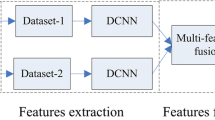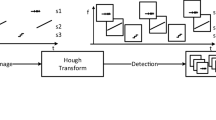Abstract
Existing algorithms for radar waveform classification currently exhibit the lower recognition accuracy, especially at the lower signal to noise ratio (SNR) environment. To remedy these flaws, this paper proposes an accurate automatic modulation classification algorithm based on dense convolutional neural networks (AAMC-DCNN). The algorithm owns the competitive advantages of strengthening the feature reuse and extracting the detailed feature, for improving the recognition performance of radar waveform at the lower SNR. First, the dense convolutional neural networks (CNN) are designed, which connects each layer to every other layer in a feed-forward pattern. In the latter, 8 types of signals are converted into time-frequency images by choi-williams distribution (CWD), and the large training and testing datasets are fabricated. Then, the transfer learning and Adam optimization are introduced. Finally, the experimental analyses are carried out to evaluate the recognition performance. It is worth mentioning that the classification accuracy can be up to 93.4% when the SNR is −8 dB, and even reach to 100% at 0 dB, which demonstrates the superior performance over others. The present work provides a sound experimental basis for further studying automatic modulation classification for the sake of future field application in electronic warfare systems.







Similar content being viewed by others
References
Ayazgok S, Erdem C, Ozturk MT, Orduyilmaz A, Serin M (2018) Automatic antenna scan type classification for next-generation electronic warfare receivers. IET Radar Sonar Navig 12(4):466–474. https://doi.org/10.1049/iet-rsn.2017.0354
Cao R, Cao JW, Mei JP, Yin C, Huang XG (2019) Radar emitter identification with bispectrum and hierarchical extreme learning machine. Multimed Tools Appl 78(20):28953–28970. https://doi.org/10.1007/s11042-018-6134-y
Chen H, Yin JJ, Yeh CM, Lu YB, Yang JY (2020) Inverse synthetic aperture radar imaging based on time-frequency analysis through neural network. J Electron Imaging 29(1):20. https://doi.org/10.1117/1.jei.29.1.013003
Gao J, Shen L, Gao L, Lu Y (2019) A rapid accurate recognition system for radar emitter signals. Electronics 8(4):463. https://doi.org/10.3390/electronics8040463
Glorot X, Bordes A, Bengio Y (2011) Deep sparse rectifier neural networks. In: Int. conf. on artificial intelligence and statistics, Fort Lauderdale, USA. pp. 315–323
Guo Q, Yu X, Ruan G (2019) LPI radar waveform recognition based on deep convolutional neural network transfer learning. Symmetry-Basel 11(4):540. https://doi.org/10.3390/sym11040540
He K, Zhang X, Ren S, Sun J (2016) Deep residual learning for image recognition. In: computer vision and pattern recognition, Nevada, USA. pp. 770–778
Huang G, Liu Z, Van Der Maaten L, Weinberger KQ (2017) Densely connected convolutional networks. In: IEEE conf. on computer vision and pattern recognition, Honolulu, USA, pp. 4700–4708
Huang Z, Ma Z, Huang G (2019) Radar waveform recognition based on multiple autocorrelation images. IEEE Access 7:98653–98668. https://doi.org/10.1109/access.2019.2930250
Ioffe S, Szegedy CJapa (2015) Batch normalization: Accelerating deep network training by reducing internal covariate shift. In: Int. Conf. on Machine Learning, Lille, France. pp. 1–11
Key ELJIA, Magazine ES (2004) Detecting and classifying low probability of intercept radar [book review]. IEEE Aerosp Electron Syst Mag 19(6):39–41. https://doi.org/10.1109/MAES.2004.1308837
Kingma DP, Ba J Adam (2015): A method for stochastic optimization. In: Int. Conf. for Learning Representations, San Diego, USA. pp. 1–15
Kishore TR, Rao KD (2017) Automatic intrapulse modulation classification of advanced LPI radar waveforms. IEEE Trans Aerosp Electron Syst 53(2):901–914. https://doi.org/10.1109/taes.2017.2667142
Kong S-H, Kim M, Linh Manh H, Kim E (2018) Automatic LPI radar wave form recognition using CNN. IEEE Access 6:4207–4219. https://doi.org/10.1109/access.2017.2788942
Linh Manh H, Kim M, Kong S-H (2019) Automatic recognition of general LPI radar waveform using SSD and supplementary classifier. IEEE Trans Signal Process 67(13):3516–3530. https://doi.org/10.1109/tsp.2019.2918983
Liu Z-M, Yu PS (2019) Classification, denoising, and deinterleaving of pulse streams with recurrent neural networks. IEEE Trans Aeros Electron Syst 55(4):1624–1639. https://doi.org/10.1109/taes.2018.2874139
Liu Y, Xiao P, Wu H, Xiao W (2015) LPI radar signal detection based on radial integration of Choi-Williams time-frequency image. J Sys Eng Electron 26(5):973–981
Lu X, Ma C, Ni B, Yang X, Reid I, Yang M (2018) Deep regression tracking with shrinkage loss. In: 15th European conference on computer vision, Munich, Germany. pp. 369–386
Lu X, Wang W, Ma C, Shen J, Shao L, Porikli F (2019) See more, know more: unsupervised video object segmentation with co-attention siamese networks. In: computer vision and pattern recognition, Long Beach, USA. pp. 3623–3632
Lundén J, Koivunen V (2007) Automatic radar waveform recognition. IEEE J Sel Top Signal Process 1(1):124–136. https://doi.org/10.1109/jstsp.2007.897055
Ma Z, Huang Z, Lin A, Huang G (2019) Emitter signal waveform classification based on autocorrelation and time-frequency analysis. Electronics 8(12):1419. https://doi.org/10.3390/electronics8121419
Noor A, Zhao YQ, Khan R, Wu LW, Abdalla FYO (2020) Median filters combined with denoising convolutional neural network for Gaussian and impulse noises. Multimed Tools Appl 4:16–18568. https://doi.org/10.1007/s11042-020-08657-4
Pan SJ, Yang Q (2009) A survey on transfer learning. IEEE Trans Knowl Data Eng 22(10):1345–1359. https://doi.org/10.1109/TKDE.2009.191
Qin Z, Zhou X, Zhang L, Gao Y, Liang Y-C, Li GY (2019) 20 years of evolution from cognitive to intelligent communications. IEEE Trans Cognitive Commun Netw 6(1):6–20. https://doi.org/10.1109/TCCN.2019.2949279
Simonyan K, Zisserman A (2014) Very deep convolutional networks for large-scale image recognition. In: computer vision and pattern recognition, Columbus, USA. pp. 1–14
Srivastava RK, Greff K, Schmidhuber J (2015) Training very deep networks. In: 28th international conference on neural information processing systems, Montrea, Canada. pp. 2377–2385
Wan J, Yu X, Guo Q (2019) LPI radar waveform recognition based on CNN and TPOT. Symmetry-Basel 11(5):725. https://doi.org/10.3390/sym11050725
Wang C, Wang J, Zhang X (2017) Automatic radar waveform recognition based on time-frequency analysis and convolutional neural network. In: IEEE Int. Conf. on Acoustics, Speech and Signal Processing, New Orleans, USA, March 2017. IEEE, new Orleans, USA, pp 2437–2441
Wang W, Lu X, Shen J, Crandall DJ, Shao L (2019) Zero-shot video object segmentation via attentive graph neural networks. In: international conference on computer vision, Seoul, Korea. pp. 9236–9245
Wang Q, Du P, Yang J, Wang G, Lei J, Hou C (2019) Transferred deep learning based waveform recognition for cognitive passive radar. Signal Process 155:259–267. https://doi.org/10.1016/j.sigpro.2018.09.038
Wang F, Yang C, Huang S, Wang H (2019) Automatic modulation classification based on joint feature map and convolutional neural network. IET Radar Sonar Navig 13(6):998–1003. https://doi.org/10.1049/iet-rsn.2018.5549
Wang Q, Du P, Liu X, Yang J, Wang G (2020) Adversarial unsupervised domain adaptation for cross scenario waveform recognition. Signal Process 171:107526. https://doi.org/10.1016/j.sigpro.2020.107526
Wei SJ, Qu QZ, Su H, Wang M, Shi J, Hao XJ (2020) Intra-pulse modulation radar signal recognition based on CLDN network. Iet Radar Sonar And Navigation 14(6):803–810. https://doi.org/10.1049/iet-rsn.2019.0436
Wu Z, Zhou S, Yin Z, Ma B, Yang Z (2017) Robust automatic modulation classification under varying noise conditions. IEEE Access 5:19733–19741. https://doi.org/10.1109/ACCESS.2017.2746140
Zhang M, Diao M, Gao L, Liu L (2017) Neural networks for radar waveform recognition. Symmetry-Basel 9(5):75. https://doi.org/10.3390/sym9050075
Zhang M, Diao M, Guo L (2017) Convolutional neural networks for automatic cognitive radio waveform recognition. IEEE Access 5:11074–11082. https://doi.org/10.1109/access.2017.2716191
Zhang J, Li Y, Yin J (2018) Modulation classification method for frequency modulation signals based on the time-frequency distribution and CNN. IET Radar Sonar Navig 12(2):244–249. https://doi.org/10.1049/iet-rsn.2017.0265
Zhang Z, Wang C, Gan C, Sun S, Wang M (2019) Automatic modulation classification using convolutional neural network with features fusion of SPWVD and BJD. IEEE Trans Signal Infor Process Net 5(3):469–478. https://doi.org/10.1109/tsipn.2019.2900201
Zhou R, Liu F, Gravelle CW (2020) Deep learning for modulation recognition: a survey with a demonstration. IEEE Access 8(99):67366–67376. https://doi.org/10.1109/ACCESS.2020.2986330
Zhu M, Li Y, Pan Z, Yang J (2020) Automatic modulation recognition of compound signals using a deep multi-label classifier: a case study with radar jamming signals. Signal Process 169:107393. https://doi.org/10.1016/j.sigpro.2019.107393
Zorzi S, Maset E, Fusiello A, Crosilla F (2019) Full-waveform airborne LiDAR data classification using convolutional neural networks. IEEE Trans Geosci Remote Sensing 57(10):8255–8261. https://doi.org/10.1109/tgrs.2019.2919472
Acknowledgments
This work was financially supported in part by the National Natural Science Foundation of China (Grant No. 61671168 and 61801143), in part by the National Natural Science Foundation of Heilongjiang Province (Grant No. QC2016085), and in part by the Fundamental Research Funds for the Central Universities (Grant No. HEUCFJ180801).
Author information
Authors and Affiliations
Corresponding author
Additional information
Publisher’s note
Springer Nature remains neutral with regard to jurisdictional claims in published maps and institutional affiliations.
Rights and permissions
About this article
Cite this article
Si, W., Wan, C. & Zhang, C. Towards an accurate radar waveform recognition algorithm based on dense CNN. Multimed Tools Appl 80, 1779–1792 (2021). https://doi.org/10.1007/s11042-020-09490-5
Received:
Revised:
Accepted:
Published:
Issue Date:
DOI: https://doi.org/10.1007/s11042-020-09490-5




